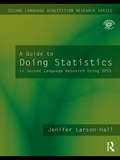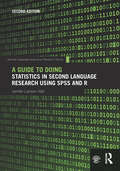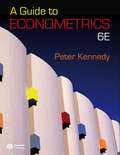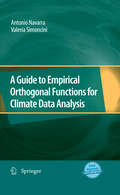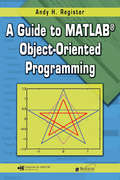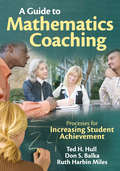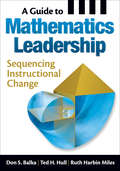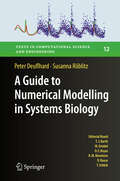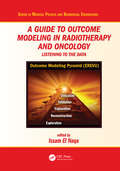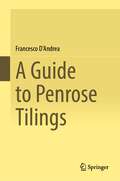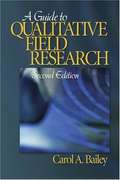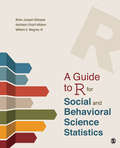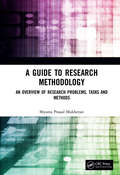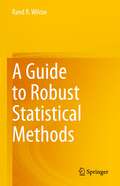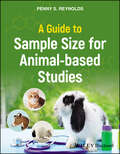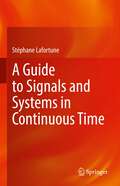- Table View
- List View
A Guide to Doing Statistics in Second Language Research Using SPSS
by Jenifer Larson-HallThis valuable book shows second language researchers how to use the statistical program SPSS to conduct statistical tests frequently done in SLA research. Using data sets from real SLA studies, A Guide to Doing Statistics in Second Language Research Using SPSS shows newcomers to both statistics and SPSS how to generate descriptive statistics, how to choose a statistical test, and how to conduct and interpret a variety of basic statistical tests. It covers the statistical tests that are most commonly used in second language research, including chi-square, t-tests, correlation, multiple regression, ANOVA and non-parametric analogs to these tests. The text is abundantly illustrated with graphs and tables depicting actual data sets, and exercises throughout the book help readers understand concepts (such as the difference between independent and dependent variables) and work out statistical analyses. Answers to all exercises are provided on the book’s companion website, along with sample data sets and other supplementary material.
A Guide to Doing Statistics in Second Language Research Using SPSS and R (Second Language Acquisition Research Series)
by Jenifer Larson-HallA Guide to Doing Statistics in Second Language Research Using SPSS and R, Second Edition is the only text available that demonstrates how to use SPSS and R as specifically related to applied linguistics and SLA research. This new edition is up-to-date with the most recent version of the SPSS software and now also includes coverage of R, a software program increasingly used by researchers in this field. Supported by a number of pedagogical features, including tip boxes and practice activities, and a wealth of screenshots, this book takes readers through each step of performing and understanding statistical research, covering the most commonly used tests in second language research, including t-tests, correlation, and ANOVA. A robust accompanying website covers additional tests of interest to students and researchers, taking them step-by-step through carrying out these tests themselves. In this comprehensive and hands-on volume, Jenifer Larson-Hall equips readers with a thorough understanding and the practical skills necessary to conducting and interpreting statisical research effectively using SPSS and R, ideal for graduate students and researchers in SLA, social sciences, and applied lingustics. For more information and materials, please visit www.routledge.com/cw/larson-hall.
A Guide to Econometrics (6th edition)
by Peter KennedyThis book designed to illuminate the logic of econometrics without formulas, providing intuition, skepticism, insights, humor, and practical advice. Designed for use in a range of courses, from undergraduate to graduate and PhD level.
A Guide to Empirical Orthogonal Functions for Climate Data Analysis
by Valeria Simoncini Antonio NavarraClimatology and meteorology have basically been a descriptive science until it became possible to use numerical models, but it is crucial to the success of the strategy that the model must be a good representation of the real climate system of the Earth. Models are required to reproduce not only the mean properties of climate, but also its variability and the strong spatial relations between climate variability in geographically diverse regions. Quantitative techniques were developed to explore the climate variability and its relations between different geographical locations. Methods were borrowed from descriptive statistics, where they were developed to analyze variance of related observations-variable pairs, or to identify unknown relations between variables. A Guide to Empirical Orthogonal Functions for Climate Data Analysis uses a different approach, trying to introduce the reader to a practical application of the methods, including data sets from climate simulations and MATLAB codes for the algorithms. All pictures and examples used in the book may be reproduced by using the data sets and the routines available in the book . Though the main thrust of the book is for climatological examples, the treatment is sufficiently general that the discussion is also useful for students and practitioners in other fields. Supplementary datasets are available via http://extra.springer.com
A Guide to Implementing MLOps: From Data to Operations (Synthesis Lectures on Engineering, Science, and Technology)
by Prafful MishraOver the past decade, machine learning has come a long way, with organisations of all sizes exploring its potential to extract valuable insights from data. However, despite the promise of machine learning, many organisations need help deploying and managing machine learning models in production. This is where MLOps comes in. MLOps, or machine learning operations, is an emerging field that focuses on the deployment, management, and monitoring of machine learning models in production environments. MLOps combines the principles of DevOps with the unique requirements of machine learning, enabling organisations to build and deploy models at scale while maintaining high levels of reliability and accuracy. This book is a comprehensive guide to MLOps, providing readers with a deep understanding of the principles, best practices, and emerging trends in the field. From training models to deploying them in production, the book covers all aspects of the MLOps process, providing readers with the knowledge and tools they need to implement MLOps in their organisations. The book is aimed at data scientists, machine learning engineers, and IT professionals who are interested in deploying machine learning models at scale. It assumes a basic understanding of machine learning concepts and programming, but no prior knowledge of MLOps is required. Whether you're just getting started with MLOps or looking to enhance your existing knowledge, this book is an essential resource for anyone interested in scaling machine learning in production.
A Guide to MATLAB Object-Oriented Programming
by Andy H. RegisterA Guide to MATLAB Object-Oriented Programming is the first book to deliver broad coverage of the documented and undocumented object-oriented features of MATLAB. Unlike the typical approach of other resources, this guide explains why each feature is important, demonstrates how each feature is used, and promotes an understanding of
A Guide to MATLAB®
by Brian R. Hunt Ronald L. Lipsman Jonathan M. RosenbergThis book is a short, focused introduction to MATLAB, a comprehensive software system for mathematics and technical computing. It should be useful to both beginning and experienced users. It contains concise explanations of essential MATLAB commands, as well as easily understood instructions for using MATLAB's programming features, graphical capabilities, and desktop interface. It also includes an introduction to SIMULINK, a companion to MATLAB for system simulation. Written for MATLAB 6, this book can also be used with earlier (and later) versions of MATLAB. This book contains worked-out examples of applications of MATLAB to interesting problems in mathematics, engineering, economics, and physics. In addition, it contains explicit instructions for using MATLAB's Microsoft Word interface to produce polished, integrated, interactive documents for reports, presentations, or on-line publishing. This book explains everything you need to know to begin using MATLAB to do all these things and more. Intermediate and advanced users will find useful information here, especially if they are making the switch to MATLAB 6 from an earlier version.
A Guide to MATLAB® for Beginners and Experienced Users
by Brian R. Hunt Ronald L. Lipsman Jonathan M. RosenbergHere is a short, focused introduction to MATLAB, a comprehensive software system for mathematics and technical computing that should be useful to both beginning and experienced users. It contains concise explanations of essential MATLAB commands, as well as easily understood instructions for using MATLAB's programming features, graphical capabilities, and desktop interface. It also includes an introduction to SIMULINK, a companion to MATLAB for system simulation. Written for MATLAB 6, this book can also be used with earlier (and later) versions of MATLAB. Chapters contain worked-out examples of applications of MATLAB to interesting problems in mathematics, engineering, economics, and physics. In addition, it contains explicit instructions for using MATLAB's Microsoft Word interface to produce polished, integrated, interactive documents for reports, presentations, or on-line publishing. This book explains everything you need to know to begin using MATLAB. Intermediate and advanced users will find useful information here, especially if they are making the switch to MATLAB 6 from an earlier version.
A Guide to Mathematics Coaching: Processes for Increasing Student Achievement
by Don S. Balka Ted H. Hull Ruth Harbin MilesDiscover how effective coaching relationships add up to improved mathematics teaching and learning! Based on principles established by NCTM and NCSM, this resource outlines a coaching process for engaging math teachers and fostering productive collaborations that lead to better teaching practice and increased student achievement. Focusing on the role of the math coach in transforming mathematics classrooms and ensuring equity, the chapters help coaches: Collaborate with teachers to align and implement curriculum Build trust and rapport with hesitant or resistant teachers Develop collegial partnerships for planning, analyzing, and reflecting on instruction Support and sustain individual and institutional change
A Guide to Mathematics Leadership: Sequencing Instructional Change
by Don S. Balka Ted H. Hull Ruth Harbin MilesWritten by three noted mathematics educators, this volume presents a process-based approach to building a high-quality mathematics program based on five NCTM principles and four NCSM leadership principles.
A Guide to Monte Carlo Simulations in Statistical Physics
by David Landau Kurt BinderDealing with all aspects of Monte Carlo simulation of complex physical systems encountered in condensed matter physics and statistical mechanics, this book provides an introduction to computer simulations in physics. The 5th edition contains extensive new material describing numerous powerful algorithms and methods that represent recent developments in the field. New topics such as active matter and machine learning are also introduced. Throughout, there are many applications, examples, recipes, case studies, and exercises to help the reader fully comprehend the material. This book is ideal for graduate students and researchers, both in academia and industry, who want to learn techniques that have become a third tool of physical science, complementing experiment and analytical theory.
A Guide to Monte Carlo Simulations in Statistical Physics
by David P. Landau Kurt Binder David P. Landau Kurt BinderDealing with all aspects of Monte Carlo simulation of complex physical systems encountered in condensed-matter physics and statistical mechanics, this book provides an introduction to computer simulations in physics. This fourth edition contains extensive new material describing numerous powerful algorithms not covered in previous editions, in some cases representing new developments that have only recently appeared. Older methodologies whose impact was previously unclear or unappreciated are also introduced, in addition to many small revisions that bring the text and cited literature up to date. This edition also introduces the use of petascale computing facilities in the Monte Carlo arena. Throughout the book there are many applications, examples, recipes, case studies, and exercises to help the reader understand the material. It is ideal for graduate students and researchers, both in academia and industry, who want to learn techniques that have become a third tool of physical science, complementing experiment and analytical theory.
A Guide to Monte Carlo Simulations in Statistical Physics
by David P. Landau Kurt BinderThis new and updated edition deals with all aspects of Monte Carlo simulation of complex physical systems encountered in condensed-matter physics, statistical mechanics, and related fields. After briefly recalling essential background in statistical mechanics and probability theory, it gives a succinct overview of simple sampling methods. The concepts behind the simulation algorithms are explained comprehensively, as are the techniques for efficient evaluation of system configurations generated by simulation. It contains many applications, examples, and exercises to help the reader and provides many new references to more specialized literature. This edition includes a brief overview of other methods of computer simulation and an outlook for the use of Monte Carlo simulations in disciplines beyond physics. This is an excellent guide for graduate students and researchers who use computer simulations in their research. It can be used as a textbook for graduate courses on computer simulations in physics and related disciplines.
A Guide to NIP Theories
by Pierre SimonThe study of NIP theories has received much attention from model theorists in the last decade, fuelled by applications to o-minimal structures and valued fields. This book, the first to be written on NIP theories, is an introduction to the subject that will appeal to anyone interested in model theory: graduate students and researchers in the field, as well as those in nearby areas such as combinatorics and algebraic geometry. Without dwelling on any one particular topic, it covers all of the basic notions and gives the reader the tools needed to pursue research in this area. An effort has been made in each chapter to give a concise and elegant path to the main results and to stress the most useful ideas. Particular emphasis is put on honest definitions, handling of indiscernible sequences and measures. The relevant material from other fields of mathematics is made accessible to the logician.
A Guide to Numerical Modelling in Systems Biology (Texts in Computational Science and Engineering #12)
by Peter Deuflhard Susanna RöblitzThis book is intended for students of computational systems biology with only a limited background in mathematics. Typical books on systems biology merely mention algorithmic approaches, but without offering a deeper understanding. On the other hand, mathematical books are typically unreadable for computational biologists. The authors of the present book have worked hard to fill this gap. The result is not a book on systems biology, but on computational methods in systems biology. This book originated from courses taught by the authors at Freie Universität Berlin. The guiding idea of the courses was to convey those mathematical insights that are indispensable for systems biology, teaching the necessary mathematical prerequisites by means of many illustrative examples and without any theorems. The three chapters cover the mathematical modelling of biochemical and physiological processes, numerical simulation of the dynamics of biological networks and identification of model parameters by means of comparisons with real data. Throughout the text, the strengths and weaknesses of numerical algorithms with respect to various systems biological issues are discussed. Web addresses for downloading the corresponding software are also included.
A Guide to Outcome Modeling In Radiotherapy and Oncology: Listening to the Data (Series in Medical Physics and Biomedical Engineering)
by Issam El NaqaThis book explores outcome modeling in cancer from a data-centric perspective to enable a better understanding of complex treatment response, to guide the design of advanced clinical trials, and to aid personalized patient care and improve their quality of life. It contains coverage of the relevant data sources available for model construction (panomics), ranging from clinical or preclinical resources to basic patient and treatment characteristics, medical imaging (radiomics), and molecular biological markers such as those involved in genomics, proteomics and metabolomics. It also includes discussions on the varying methodologies for predictive model building with analytical and data-driven approaches. This book is primarily intended to act as a tutorial for newcomers to the field of outcome modeling, as it includes in-depth how-to recipes on modeling artistry while providing sufficient instruction on how such models can approximate the physical and biological realities of clinical treatment. The book will also be of value to seasoned practitioners as a reference on the varying aspects of outcome modeling and their current applications. Features: Covers top-down approaches applying statistical, machine learning, and big data analytics and bottom-up approaches using first principles and multi-scale techniques, including numerical simulations based on Monte Carlo and automata techniques Provides an overview of the available software tools and resources for outcome model development and evaluation, and includes hands-on detailed examples throughout Presents a diverse selection of the common applications of outcome modeling in a wide variety of areas: treatment planning in radiotherapy, chemotherapy and immunotherapy, utility-based and biomarker applications, particle therapy modeling, oncological surgery, and the design of adaptive and SMART clinical trials
A Guide to Penrose Tilings
by Francesco D'AndreaThis book provides an elementary introduction, complete with detailed proofs, to the celebrated tilings of the plane discovered by Sir Roger Penrose in the '70s. Quasi-periodic tilings of the plane, of which Penrose tilings are the most famous example, started as recreational mathematics and soon attracted the interest of scientists for their possible application in the description of quasi-crystals. The purpose of this survey, illustrated with more than 200 figures, is to introduce the curious reader to this beautiful topic and be a reference for some proofs that are not easy to find in the literature. The volume covers many aspects of Penrose tilings, including the study, from the point of view of Connes' Noncommutative Geometry, of the space parameterizing these tilings.
A Guide to Publishing for Academics: Inside the Publish or Perish Phenomenon
by Jay LiebowitzMost academics still wrestle with the "publish or perish" phenomenon. Based on Dr. Liebowitz's 25 years serving as the editor-in-chief of a leading international journal, along with insights from some of the most knowledgeable journal editors, this book shares key lessons learned to help new professors, doctoral students, and practitioner-scholars
A Guide to Qualitative Field Research
by Carol A. BaileyThoroughly revised, the Second Edition of A Guide to Qualitative Field Research provides novice researchers with comprehensive and accessible instructions for conducting qualitative field research. Using rich examples from classic ethnographies to help bring abstract principles alive, author Carol A. Bailey thoroughly explains the entire research process from selecting a topic to writing the final manuscript, and all of the steps in between!
A Guide to R for Social and Behavioral Science Statistics
by Brian Joseph Gillespie Dr. William E. Wagner Kathleen Charli HibbertA Guide to R for Social and Behavioral Science Statistics is a short, accessible book for learning R, geared toward social and behavioral science students. Instructors Brian Gillespie, Kathleen Hibbert, and William E. Wagner, III, have combined a review of introductory statistics with an introduction to R to teach readers two of the most valuable skills for research and in the workplace. Designed for readers with no knowledge of statistics or R, A Guide to R for Social and Behavioral Science Statistics follows the most common progression of statistics, starting with basic descriptive statistics, and continuing up through inferential statistics and regression. This text provides step-by-step instructions for working with R, starting with downloading and installing R and RStudio®, featuring code and output so readers can follow along with each step. Readers can apply their knowledge with examples and exercises featuring data from the General Social Survey in each chapter. Tips on R show users how to avoid common pitfalls in R and most efficiently use the RStudio interface. With frequent reminders of statistical concepts to accompany instructions and tips in R, this text helps readers master R for statistics in the social and behavioral sciences.
A Guide to R for Social and Behavioral Science Statistics
by Brian Joseph Gillespie Dr. William E. Wagner Kathleen Charli HibbertA Guide to R for Social and Behavioral Science Statistics is a short, accessible book for learning R, geared toward social and behavioral science students. Instructors Brian Gillespie, Kathleen Hibbert, and William E. Wagner, III, have combined a review of introductory statistics with an introduction to R to teach readers two of the most valuable skills for research and in the workplace. Designed for readers with no knowledge of statistics or R, A Guide to R for Social and Behavioral Science Statistics follows the most common progression of statistics, starting with basic descriptive statistics, and continuing up through inferential statistics and regression. This text provides step-by-step instructions for working with R, starting with downloading and installing R and RStudio®, featuring code and output so readers can follow along with each step. Readers can apply their knowledge with examples and exercises featuring data from the General Social Survey in each chapter. Tips on R show users how to avoid common pitfalls in R and most efficiently use the RStudio interface. With frequent reminders of statistical concepts to accompany instructions and tips in R, this text helps readers master R for statistics in the social and behavioral sciences.
A Guide to Research Methodology: An Overview of Research Problems, Tasks and Methods
by Shyama Prasad MukherjeeResearch Methodology is meant to provide a broad guideline to facilitate and steer the whole of a research activity in any discipline. With the ambit and amount of research increasing by the day, the need for Research Methodology is being widely appreciated. Against this backdrop, we notice the dearth of well-written books on the subject. A Guide to Research Methodology attempts a balance between the generic approach to research in any domain and the wide array of research methods which are to be used in carrying out different tasks in any research. Discussions on these research methods appropriate in various disciplines have focused on the research tasks, keeping in mind the fact that a single such task like a comparison among alternatives may involve several methods from seemingly distinct areas. Unique features of this volume, as will be evident to a discerning reader, include: A detailed discussion on problem areas for research in several domains An illustrative and ampliated list of research problems drawn from different disciplines which can be pursued by interested research workers A comprehensive delineation of Research Design supported by illustrations An elaborate engagement with models with a note on model uncertainty Focus on recent and emerging models, methods and techniques A novel treatment of data analysis where the nature of data and the objective(s) of analysis justify drawing upon a variety of techniques for analysis This book will serve the purpose of a pre-PhD or a Master-level course-work for students of any discipline with a basic knowledge of quantitative analysis. In fact, anyone aspiring to take up meaningful research work will find the content useful and interesting.
A Guide to Robust Statistical Methods
by Rand R. WilcoxRobust statistical methods are now being used in a wide range of disciplines. The appeal of these methods is that they are designed to perform about as well as classic techniques when standard assumptions are true—but they continue to perform well in situations where classic methods perform poorly. This book provides a relatively non-technical guide to modern methods. The focus is on applying modern methods using R, understanding when and why classic methods can be unsatisfactory, and fostering a conceptual understanding of the relative merits of different techniques. A recurring theme is that no single method reveals everything one would like to know about the population under study. An appeal of robust methods is that under general conditions they provide much higher power than conventional techniques. Perhaps more importantly, they help provide a deeper and more nuanced understanding of data. The book is for readers who had at least one semester of statistics, aimed at non-statisticians.
A Guide to Sample Size for Animal-based Studies
by Penny S. ReynoldsA Guide to Sample Size for Animal-based Studies Understand a foundational area of experimental design with this innovative reference Animal-based research is an essential part of basic and preclinical research, but poses a unique set of experimental design challenges. The most important of these are the 3Rs − Replacement, Reduction and Refinement − the principles comprising the ethical framework for humane animal-based studies. However, many researchers have difficulty navigating the design trade-offs necessary to simultaneously minimize animal use, and produce scientific information that is both rigorous and reliable. A Guide to Sample Size for Animal-based Studies meets this need with a thorough, accessible reference work to the subject. This book provides a straightforward systematic approach to “rightsizing” animal-based experiments, with sample size estimates based on the fundamentals of statistical thinking: structured research questions, variation control and appropriate design of experiments. The result is a much-needed guide to planning animal-based experiments to ensure scientifically valid and reliable results. This book offers: Step-by-step guidance in diverse methods for approximating and refining sample size Detailed treatment of research topics specific to animal-based research, including pilot, feasibility and proof-of-concept studies Sample size approximation methods for different types of data − binary, continuous, ordinal, time to event − and different study types − description, comparison, nested designs, reference interval construction and dose-response studies Numerous worked examples, using real data from published papers, together with SAS and R code A Guide to Sample Size for Animal-based Studies is a must-have reference for preclinical and veterinary researchers, as well as ethical oversight committees and policymakers.
A Guide to Signals and Systems in Continuous Time
by Stéphane LafortuneThis textbook is a concise yet precise supplement to traditional books on Signals and Systems, focusing exclusively on the continuous-time case. Students can use this guide to review material, reinforce their understanding, and see how all the parts connect together in a uniform treatment focused on mathematical clarity. Readers learn the “what”, “why” and “how” about the ubiquitous Fourier and Laplace transforms encountered in the study of linear time-invariant systems in engineering: what are these transforms, why do we need them, and how do we use them? Readers will come away with an understanding of the gradual progression from time-domain analysis to frequency-domain and s-domain techniques for continuous-time linear time-invariant systems. This book reflects the author’s experience in teaching this material for over 25 years in sophomore- and junior-level required engineering courses and is ideal for undergraduate classes in electrical engineering.
